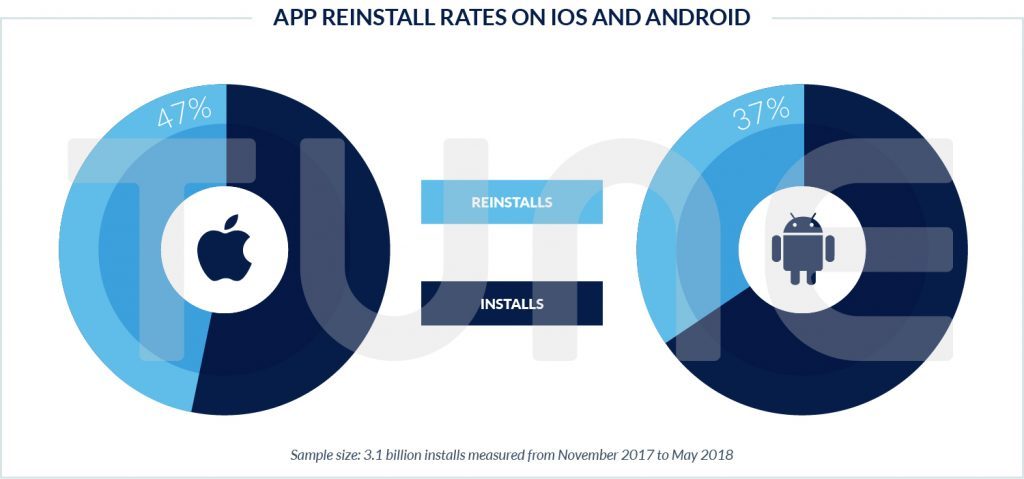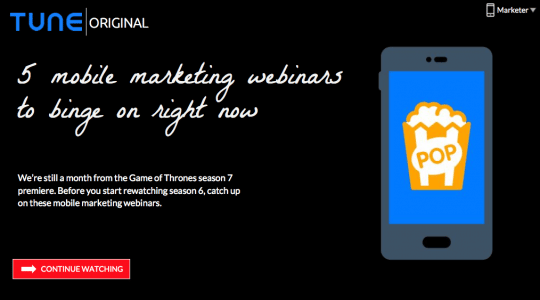Last week we revealed that a huge percentage of app “installs” are actually reinstalls. That 42% of the massive 3.1 billion install dataset we analyzed were actually users reinstalling apps that they had previously deleted.
The full and free report is available here.
But the big question is obvious …
What Does This Mean for App Marketers?
The reality is that it’s early days for understanding reinstalls.
TUNE is using a new signal from the App Store to understand reinstalls on the iOS side, and similar technology from Google Play on the Android side. Previously, what is actually a reinstall would simply be seen by a marketer as an app open — a dormant app user returning to life.
That’s partially accurate, of course, but not fully expressive of multiple important factors:
- what the user actually did
- why the user deleted the app in the first place
- how the user actually came to reinstall the app
- why the user went through the effort of reinstalling the app
With new data come new opportunities, and understanding these dynamics will help app marketers address this unique opportunity.
One thing we have seen in the data: reinstalled users have a LOT more activity, especially in the first days and weeks after the reinstall. We’ll be working more on this data in the near future to understand this better. But here are some early insights to think about as your see new data popping up in Attribution Analytics.
Insights to Keep in Mind
1) Reinstalls are purposeful
It’s important to remember: reinstalls are very purposeful. They are not random drive-by installs. People who reinstall do so for a reason and use the app significantly in the hours and days immediately following the reinstall. This is prime time for making and impact, and for converting a casual user into a customer.
Treat it as such.
2) Occasional-use apps are the most reinstalled
You have to know your app, and you have to know your category.
Travel apps (e.g., London subway mapping app), productivity apps (try it, dump it, try it again), and social apps are most reinstalled. You can find the other top categories, such as navigation, news, and education in our original blog post.
If this is where you fit, you need to work hard to engage and help users and customers find long-term value. That could be in your original app, or in subsequent apps. For example, perhaps you have London subway mapping, but you also have Tokyo, and New York, and Lisbon, and 53 other global cities.
Is there a way you can leverage the initial London app install into multiple installs? Or, should your app be focused on all global subway cities? You might lose a bit on ASO but gain more on stickiness and engagement, especially if you have asked for and received location tracking rights, and can pop up an alert when a traveler is in a city where you have coverage.
Alternatively, is there a complementary app that you can suggest — even if it’s not your own — with a partner who can return the favor later?
3) Reinstalls are about giving a brand another try
The most common reason for reinstalling is to give an app another try. The goal should be that this time, the app demonstrates its value and sticks.
Since this is so common, publishers should consider a specific re-onboarding flow that:
- enables people to do what they want immediately
- recognizes that they’ve “been here” before
- understands that a few things might have changed
- without intruding into user flow, highlights recent or new high -alue components of the app
To do so, of course, you’ll need cohort data that indicates that an “install” is actually a reinstall.
4) Games should do something special
Games are the most reinstalled apps: they are reinstalled 55% more frequently than non-game apps. High on the list are Strategy games and Arcade games.
If you’d like to keep these players in your game experience, why not bonus returning players with something special to thank them for re-engaging? Giving them a boost in the game might be all that you need to convert a casual player to an engaged player … maybe even a mini-whale.
5) Search is how people mostly find apps they previously had
Most people re-find an app that they’re going to reinstall via search on the App Store or Google Play. That means ASO matters.
It also means that the value proposition on your app listing should definitely include NEW or JUST RELEASED or IMPROVED or similar highlighting of important updates. And it wouldn’t hurt to keep at least trickle campaigns going on both Google Play and the App Store to capture some of this low-hanging fruit.
5) Big apps and big publishers: you get more
Do you have millions of users, or even hundreds of millions? Reinstalls are proportionately more of a phenomenon for you than for smaller apps. That means you should pay specific attention to reinstallers and have specific flows and onboarding to maximize your (re)opportunity to engage.
6) Goodbye is not always forever
App marketers have sometimes adopted the notion that attrition is a fact of life and the users who go are gone forever. This is simply not true.
Gone does not always mean gone forever.
Ultimately, you may want to push registration to an earlier point in your onboarding of new users or customers. Having multiple ways to connect with them (email, push, SMS, messaging app, etc.) could be the difference between true attrition rates of 70% or 90% … if you can reconnect and re-engage in multiple ways, that’s a critically important opportunity.
Ultimately, trying to get non-app-dependent messaging information in privacy-appropriate and permissioned ways to enable re-engagement with app deleters via means you control at least some part of your own re-engagement efforts.
Change the Information, Change the Thinking
Ultimately, app publishers and marketers have to recognize that some of what they previously saw as re-engagement was actually a re-download. Push messaging and in-app messaging won’t reach these app deleters, but a new ad campaign might.
Of course, that’s going to cost a few dollars. But having alternate ways to connect with lapsed users could be almost free.
One thing is clear, however:
The key for mobile marketers is still to make an impact significant enough in users’ first app use experience that even those who eventually give up on your app and delete it are willing to give you a second try later one. Building in additional options for connecting to even lapsed users to let them know about new features, new opportunities, new bug fixes, and more, might make all the difference between an app that dies by churn and one that lives by engagement.
A great way to start?
Get the full App Reinstalls report here.
Author
Before acting as a mobile economist for TUNE, John built the VB Insight research team at VentureBeat and managed teams creating software for partners like Intel and Disney. In addition, he led technical teams, built social sites and mobile apps, and consulted on mobile, social, and IoT. In 2014, he was named to Folio's top 100 of the media industry's "most innovative entrepreneurs and market shaker-uppers." John lives in British Columbia, Canada with his family, where he coaches baseball and hockey, though not at the same time.





Leave a Reply
You must be logged in to post a comment.